Core Theory and Programming Patterns
Navigate with keyboard arrows in all directions.
Use the control on the bottom right part as page availability hint.
Content
1. Core Theory
- Create Data
- Read Data
- Update Data
- Delete Data
2. Programming Patterns
- General Patterns
- Function Patterns
Content Motivation
Why C R U D operations as backbone for core theory presentation?
- We need applications to manage data
- C R U D is all about data
- Programming Language = in-memory C R U D operations
Create (R U D)
How to introduce data into your system...
Mozila Reference:
You use variables as symbolic names for values in your application. The names of variables, called identifiers, conform to certain rules.
- Cluttered with too many terms -> variables, names, identifiers
- It is better to stress on the fact that we have a mean to access data (identifier)
- ... rather to stress on the fact that we are able to change this data (variable)
- So I prefer the term 'identifier' for theory explanation!

What About Object Creation?
- We create objects via variable declarations
- Property names refer to data but they differ from identifiers in their resolution strategy
var obj = {prop: ‘propValue’};
Summary
The only way to create data is with:
- Variable declarations
- Function declarations
The Importance Of Thinking In Terms of Identifiers
var Object = function () {
this.prop = "propValue";
};
var obj = new Object();
assertEquals("propValue", obj.prop);
Always think to what your identifier is pointing to!
In our example 'Object' identifier points to different function not the built-in provided by JavaScript
(C) Read (U D)
How to find your data...
JavaScript code is executed in a context - execution context (EC)
- By default we are runing code in a context called Global Context (GC)
- Understanding data resolution means understanding execution context
How to create context different from GC?
A: The (almost) only way to create a new context is to invoke JavaScript function!
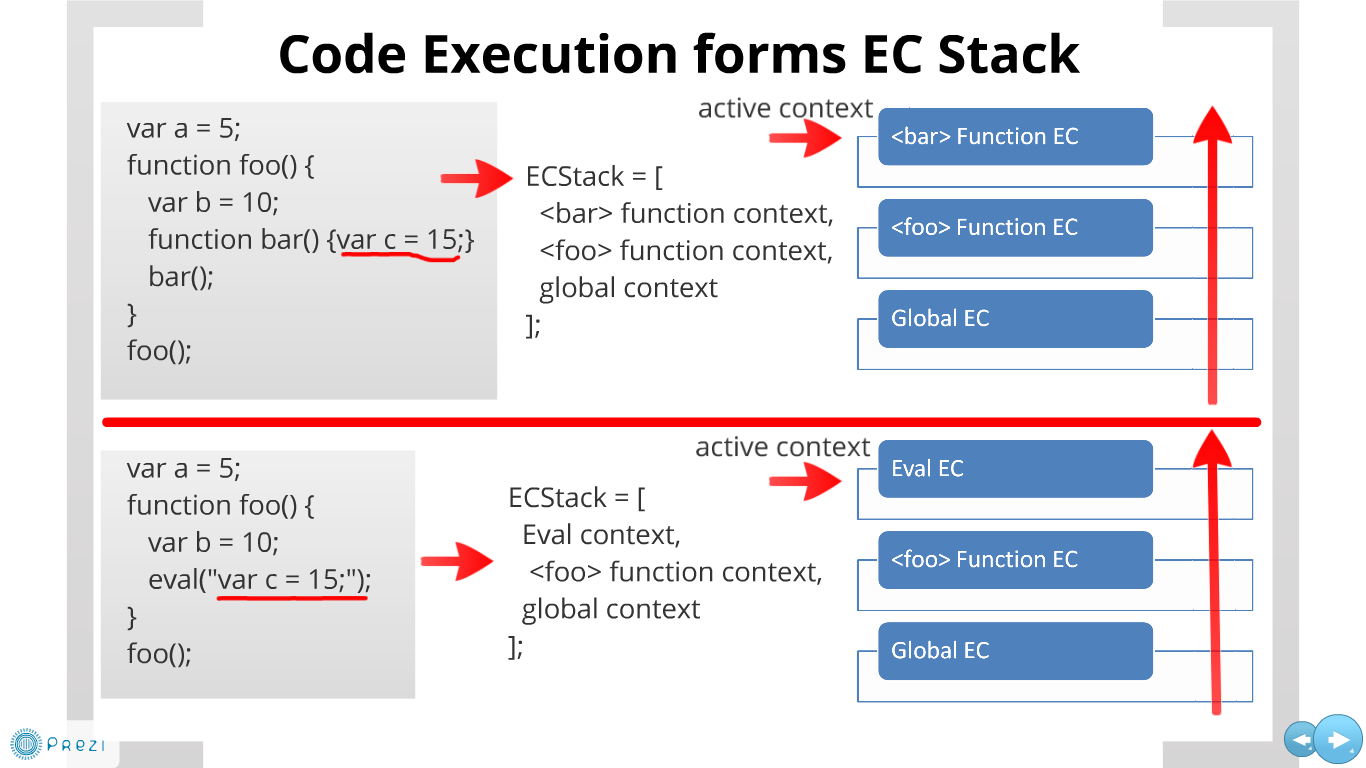
What is the purpose of having Execution Contexts?
A: To manage data visibility
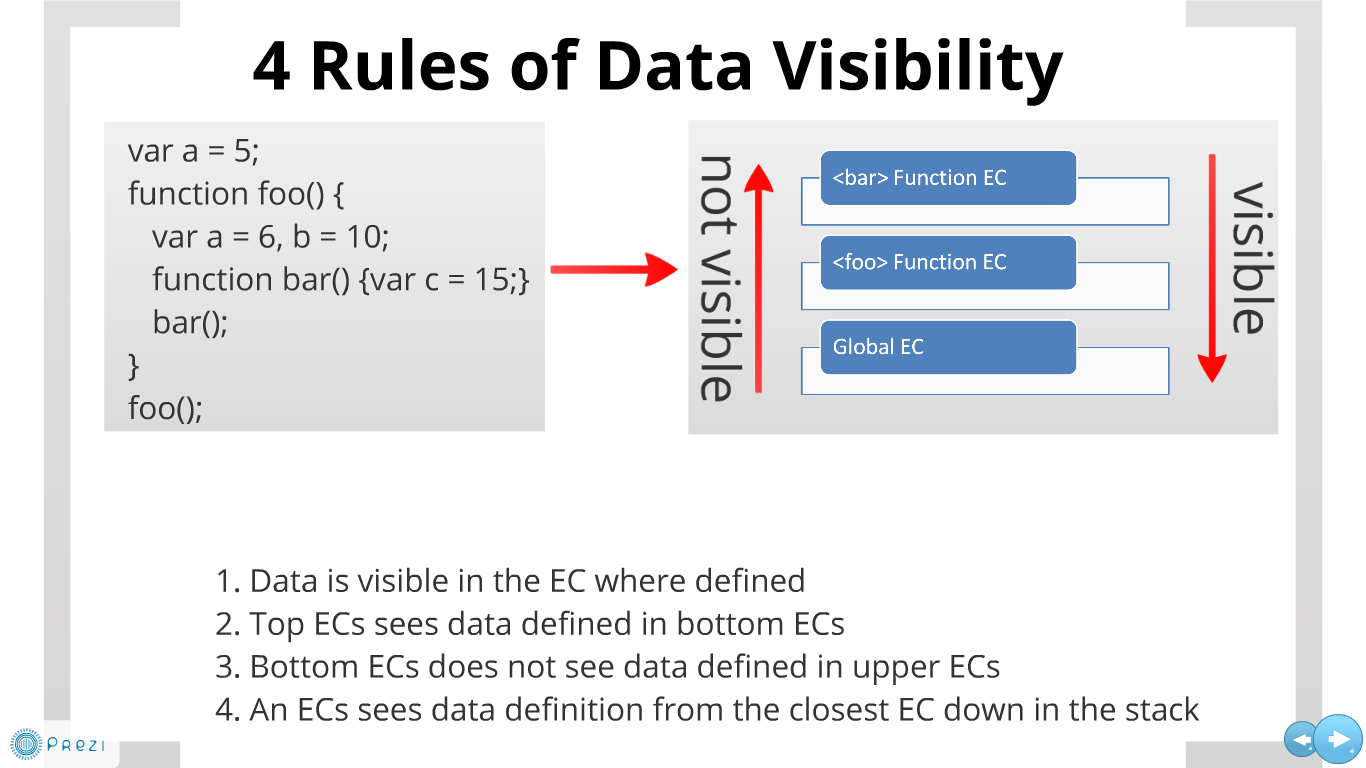
How these rules are achieved internally?
A: Try to understand the Execution Context structure
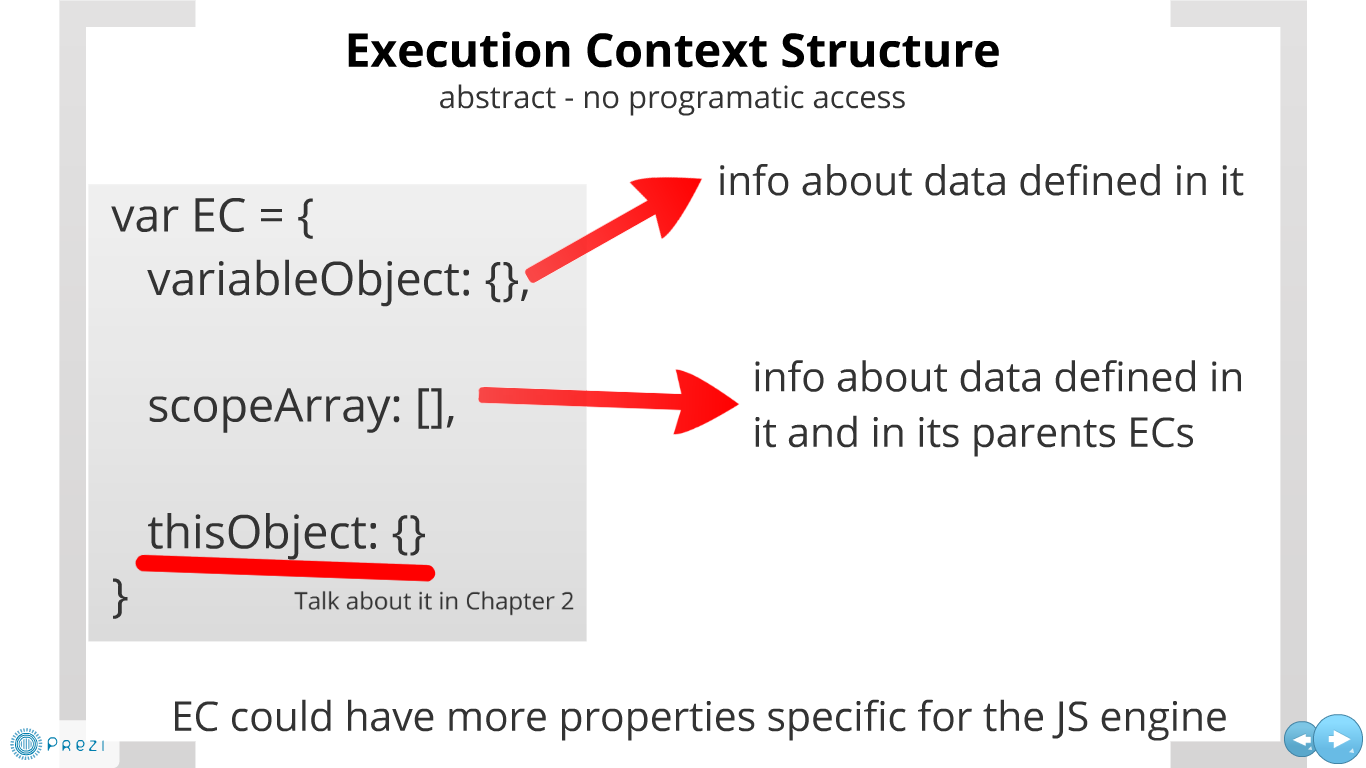



Dynamic Scope Array - 'With' Statement
//Scope = VO.scopeArray
var x = 10, y = 10;
with( { x : 20 } ) {
//Scope = withObject + VO.scopeArray
assertEquals(x, 20);
assertEquals(y, 10);
var x = 30, y = 30;
assertEquals(x, 30);
assertEquals(y, 30);
}
//Scope = VO.scopeArray
assertEquals(x, 10);
assertEquals(y, 30);
Dynamic Scopes - Catch Clause
try {
...
} catch (ex) {
//Scope = catchObject + VO.scopeArray
alert(ex);
}
A catch clause creates temporary scope object
with single property.
var catchObject = {
ex: {exception object}
};
Question 1
alert(p); // ? var p = 5; alert(p); // ? var p = 6; alert(p); // ?
Question 1 Answer
alert(p); // undefined var p = 5; alert(p); // 5 var p = 6; alert(p); // 6
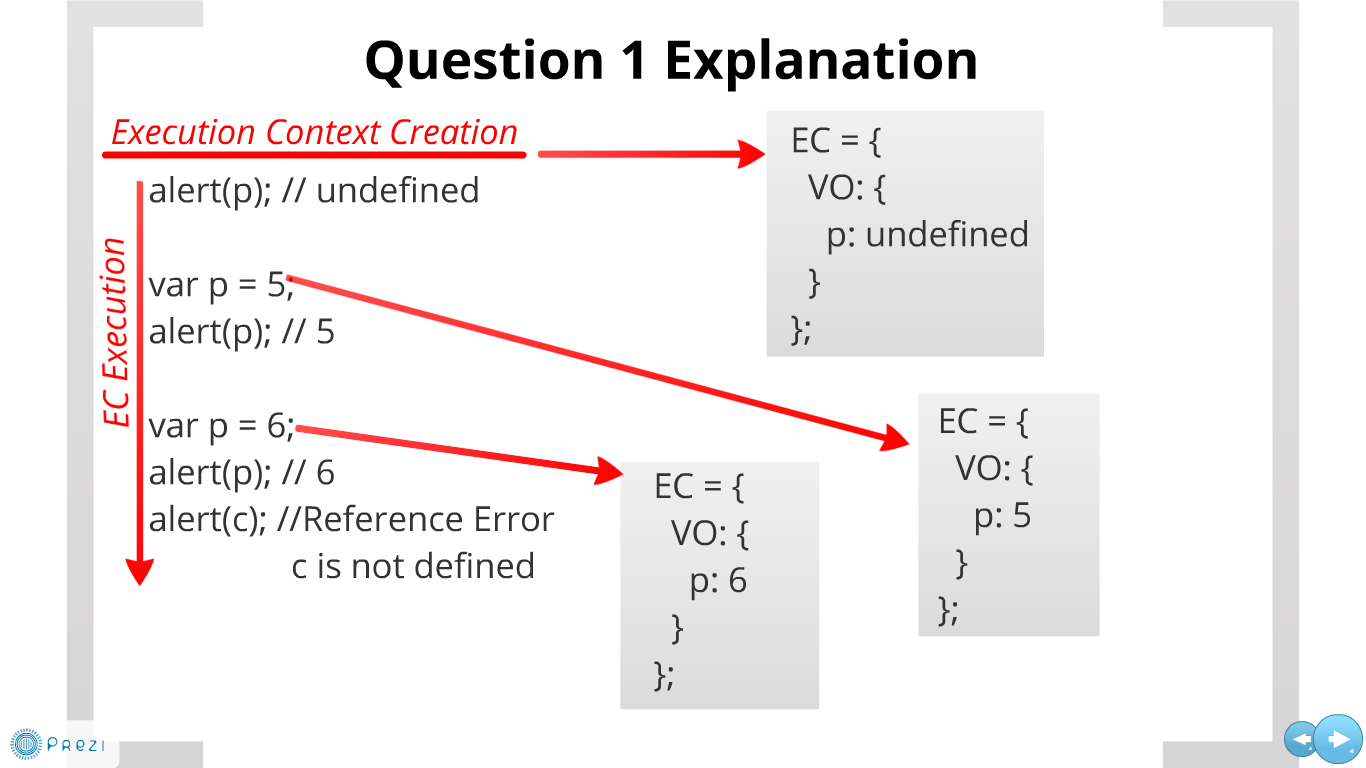
Conclusion After Question 1
All declarations are moved (hoisted) on top of the context
With other words: All identifiers are created during context creation
Question 2
alert(typeof x); // ?
var x = 10;
alert(x); // ?
x = 20;
function x() {};
alert(x); //?
Question 2 Answer
alert(typeof x); // function
var x = 10;
alert(x); // 10
x = 20;
function x() {};
alert(x); // 20
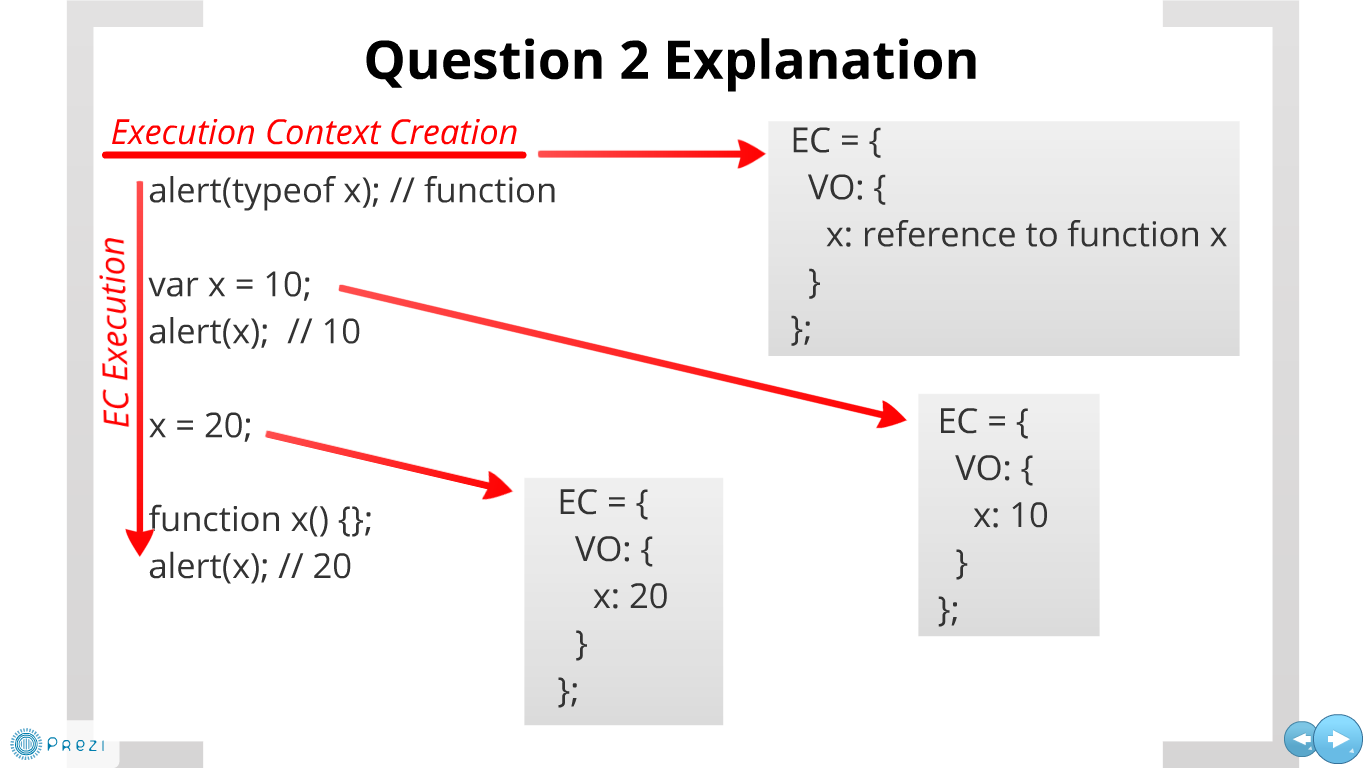
Conclusion After Question 2
Identifiers created as a result of function declaration gets their values at context creation phase
Question 3
function test() {
foo(); // ?
bar(); // ?
var foo = function () {
alert("foo");
};
function bar() {
alert("bar");
}
}
test();
Question 3 Answer
function test() {
foo(); // TypeError "foo is
not a function"
bar(); // "bar"
var foo = function () { //FE
alert("foo");
};
function bar() { // FD
alert("bar");
}
}
test();
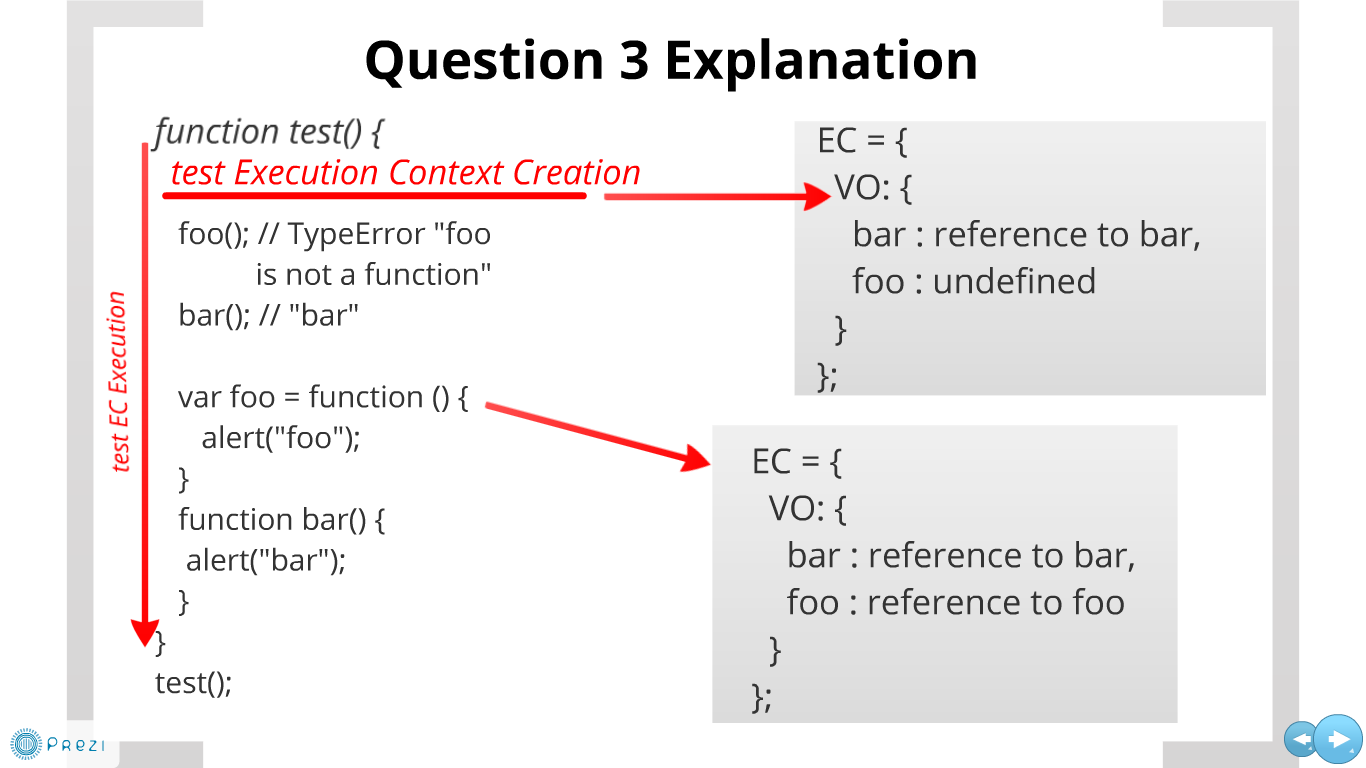
Conclusion After Question 3
Make difference between Function Declarations and Function Expressions
Identifiers that points to functions created with expression gets their value at Context Execution Phase
Function Expressions Definition
Defines a function as a part of a larger expression syntax (typically a variable assignment, callback etc.):
var f = function() {};
Anonymous FE does not introduce identifier because they do not have name!
Named FE introduce identifier visible only in the context created by NFE itself
Named Function Expressions
var test = function test1() {
//test1 is valid identifier here
};
//test is valid identifier here
//test1 is NOT valid identifier here
In Some IE versions test1 could be leaked into the parent context
Best Practice: var f = function f() {};
Very Recommended Readings About Functions By The Following Authors:
And now the most essential part...


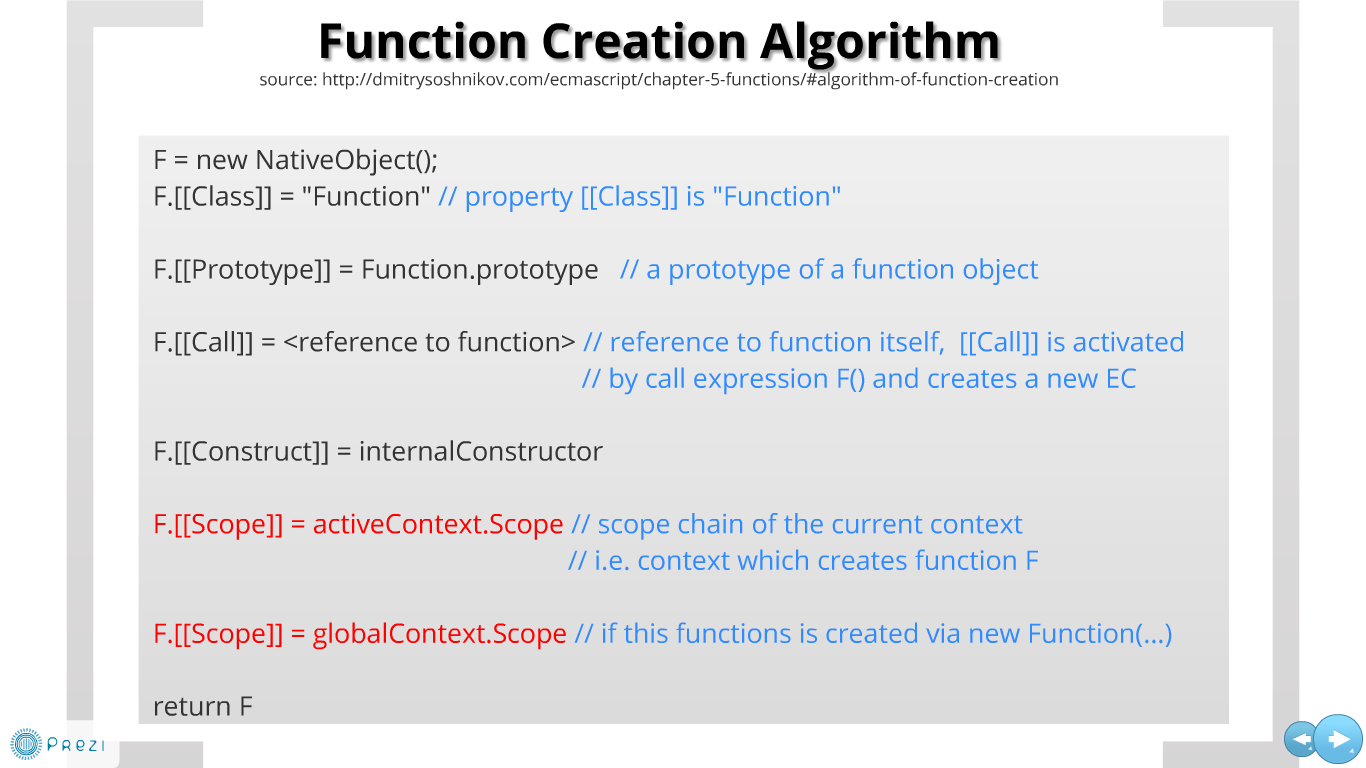
Function Created With Function Constructor
var x = 10;
function foo() {
var x = 20;
var y = 30;
var foo = function () {alert(x); alert(y);};
var bar = new Function('alert(x); alert(y);');
foo(); //20, 30
bar(); // 10, "y" is not defined
}
Eval Example
var y = 100;
function f() {
var y = 10;
alert(y);
}
f(); //10
alert(y); //100
var y = 100;
eval('var y = 10; alert(y)'); //10
alert(y); //10
Eval Facts
Eval Creates New Execution Context
Eval Augments The Calling Context
In the strict-mode of ES5, eval already does not influence the calling context, but instead evaluates the code in the local sandbox.
Data Resolution Summary
Closures In EcmaScript
Dmitry Soshnikov:
So if you completely understand the [[Scope]] and a scope chain topics, which in detail were discussed in the chapter 4, the question on understanding closures in ECMAScript will disappear by itself.
Closures General Theory
Funarg: Function used as function argument
the anonymous function is funarg
exampleFunc -> Higher Order Function
function exampleFunc(funArg) {
funArg();
}
exampleFunc(
function () {
alert('funArg');
}
);
Closures General Theory
Function Valued Functions: Functions that return other functions
(function functionValued() {
return function () {
alert('returned function is called');
};
})()();
Closures General Theory
First Class Functions: Can be passed as arguments and returned from other functions
In EcmaScript all functions are first class

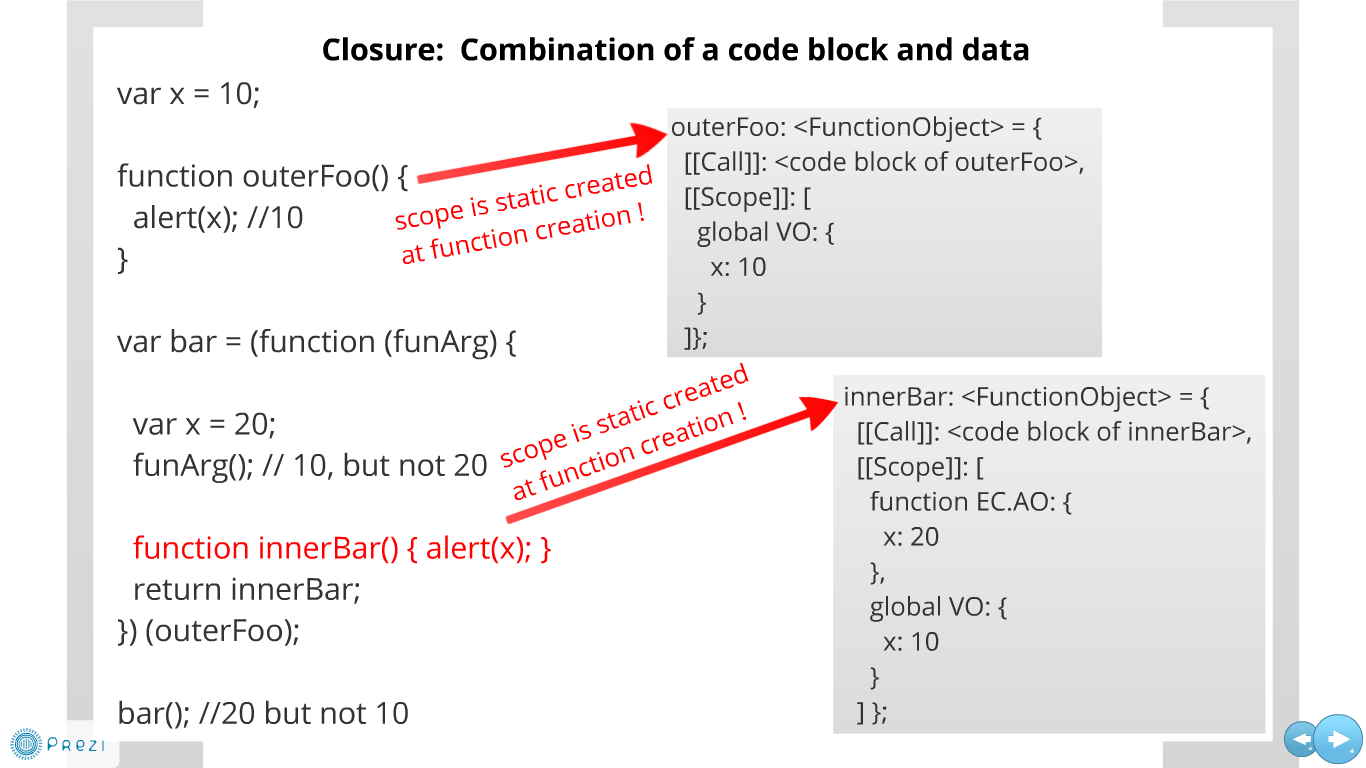
One [[Scope]] for all closures per context
var firstClosure;
var secondClosure;
function foo() {
var x = 1;
firstClosure = function () { return ++x; };
secondClosure = function () { return --x; };
x = 2;
alert(firstClosure()); // 3
}
foo();
alert(firstClosure()); // 4
alert(secondClosure()); // 3
Closures Summary
All functions, independently from their type - function expression (anonymous, named) or function declaration - are closures!
Exception is Function created with Function constructor which scope contain only global object
From the practical viewpoint those functions are interesting which are:
1. passed as arguments and uses free variables
2. returned inner function (continue to exist after their parent context is finished)
(C R) Update (D)
Am I actually updating my data?
References To Immutable Objects
What do we do when we need to change the object?
In many languages it is used Copy-on-write(COW)
Clone the object it points to
Change the pointer value
Proceed with mutation
...but not in JavaScript
There is no way to modify a string
str.concat('modification') doesn’t modify str at all, it returns a new string with the replacement executed.
(C R U)Delete
Deletion is still possible :)
Example 1
var o = { x: 1 };
delete o.x; // true
o.x; // undefined
Example 2
var x = 1; delete x; // false x; // 1
Example 3
function x(){}
delete x; // false
typeof x; // "function"
Why do these examples work like that?
A: Understand the difference between identifiers and properties.
See next...
Identifiers VS Properties
Identifiers (indirect property creation):
- Variable And Function Declaration Creates Identifiers
- The identifiers become properties of Variable Object
Properties(direct creation):
- Object property declaration -> var obj = {x: 5;}
- Undeclared assignments (no var) -> x = 5, creates property on the GO
- Properties does NOT become properties of the Variable Object
Both the identifiers and the properties have properties
ReadOnly
DontEnum
Internal
DontDelete
- Identifiers have DontDelete property set to true
- Properties have DontDelete property set to false
Delete operator checks "DontDelete" property to decide what to do
var o = { x: 1 };
delete o.x; // true -> x is property and its 'DontDelete' property is false
o.x; // undefined
var x = 1; delete x; // false -> x is identifier and its 'DontDelete' property is true x; // 1
function x(){}
delete x; // false -> x is identifier and its 'DontDelete' property is true
typeof x; // "function"
Be careful with Firebug
var x = 1; delete x; // true x; // undefined
- Firebug execute the code in Eval statement
- Declarations inside eval does not set DonDelete to true
Complete Resolution Strategy
Identifier (Data) Resolution:
- Search in: own AO, parents AO, GO, GO.prototype
//Yes it is searching in GO.prototype as well
function foo() { alert(x); }
Object.prototype.x = 10;
foo(); // 10
Property (Nested Data) Resolution:
- Search in prototype chain
- It involves identifier resolution first
-> obj.propName requires 'obj' identifier resolution first